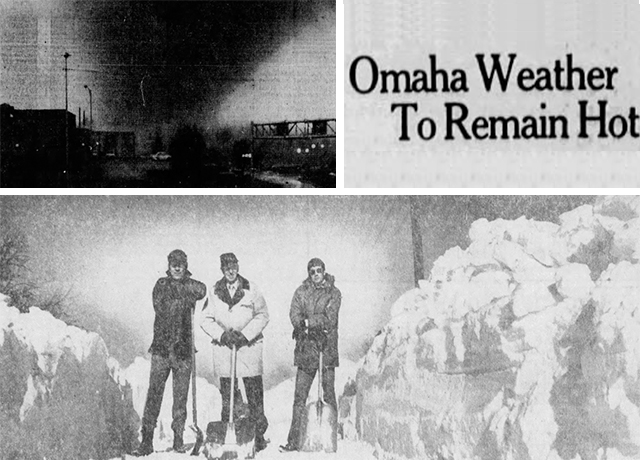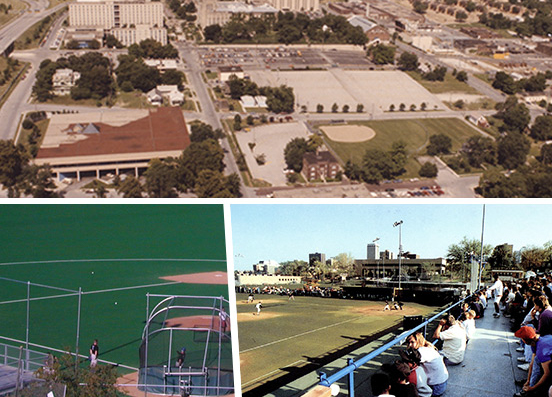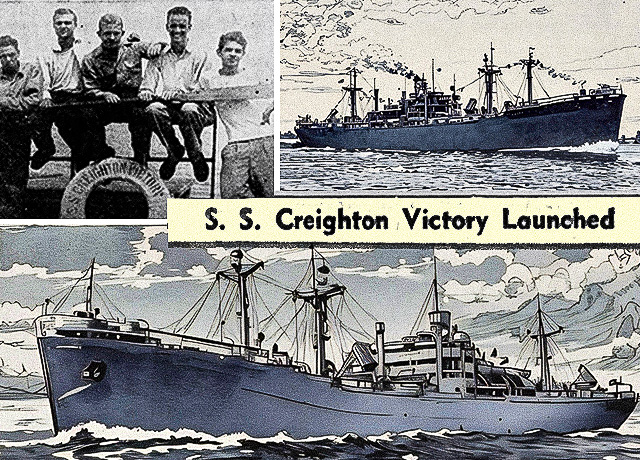Featured Testimonial About Creighton University

The Creighton Stadium, with its glory past and the gradual coming of disuse and disrepair, had to go. But it once stood for a great deal.
Creighton football
This is the second installment of a three-part series about the early days, abrupt end and short-lived comeback of Creighton University’s football team. The story continues with Part Three.
Part One — 1891: The Rise of Creighton Football
Part Two — 1942: The Fall of Creighton Football
Part Three — 1983: The “Rise” of Creighton Football
Epilogue: Images of Creighton football and its stadium
* * *
Part Two — 1942: The Fall of Creighton Football

By Micah Mertes
The Bluejays didn’t know it yet, but they were playing the final game in Creighton football’s history.
On Nov. 21, 1942, about 9,000 fans at Creighton Stadium watched as the Bluejays fell to their Missouri Valley Conference rival Tulsa, 33-19. Shortly after, the season was cut short, and Creighton suspended football and basketball competition for the duration of World War II.
There were multiple reasons: the difficulties of wartime travel; equipment and facilities being used for the government’s physical fitness program; and the draft status of many players themselves. (According to an Omaha World-Herald article, 28 players from the 1942 team were obligated to military service. At least two were killed in action.)
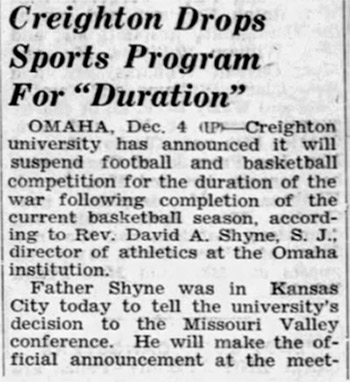
At the time, there was no clear indication this would be Creighton football’s last season for good. Most students and alumni assumed the sport, like basketball, would return.
But four years later, in February of ’46, Creighton President William H. McCabe, SJ, wrote a letter explaining why Creighton football wouldn’t resume in the immediate future. Simply put: It cost too much to field a football team.
“The decision is based on Creighton’s reasonable unwillingness to accept the scholastic and financial hardship unfortunately involved in intercollegiate football competition in our day,” McCabe wrote. “If and when these hardships are eliminated, I predict the University will gladly welcome back the virtues of intercollegiate football rivalry. We will continue basketball.”
A World-Herald article described the reaction to the University’s decision as "regret tempered with understanding."
For years after, fans held out hope for the sport’s return. Hundreds of students held rallies for the program to be reinstated. Alumni wearing football uniforms interrupted several campus events. Rumors and speculation thrived.
The last nail in the coffin came in the fall of ’48, when Creighton officially resigned its football team from the Missouri Valley Conference.
Creighton football was over. Final record: 183-139-27.
Creighton was renowned for having superior athletic teams. Then came the war and a weakening of sports in schools from coast to coast.
— 1949 Blue Jay yearbook

* * *
Creighton Stadium would surrender slowly.
The structure, which stood south of Burt Street and directly west of the Old Gymnasium, survived in some form for another 20 years.
The quarter-mile cinder track around the football field hosted meets up until Creighton dropped its track program in 1961. (“It is difficult to say when track will be reinstated,” the supervisor of athletics said at the time.) The football field itself continued to be used by ROTC cadets, intramural football squads and local high school teams.
The 6,000 seats of Creighton Stadium’s south stands were the first to go, making way for the Eppley Building (then home to what is now the Heider College of Business). A few years later, demolition crews finished the job to make room for the Criss Complex.
In the Creightonian’s farewell to the stadium, they wrote:
“The Creighton Stadium, with its glory past and the gradual coming of disuse and disrepair, had to go. But it once stood for a great deal. It was the showpiece of Creighton and indeed, of the area.”
In its last gasp, the stadium rallied.
This structure had been built to last. It was so well built — braced by such a robust web of steel rods in its concrete walls — that blow torches were needed to break it down.
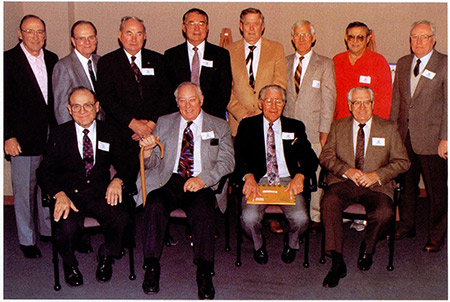
* * *
Memories of Creighton football have proved just as resilient. No one kept the story going as much as the 1942 team itself.
On Nov. 21, 1992 — 50 years to the day and hour of Creighton’s last football game — members of the team celebrated the anniversary with a prime rib lunch on campus. For dessert, they ate a chocolate cake in the shape of a football, with laces and the letter “C” in icing.
They reminisced about a time when thousands of fans came to see them at Creighton Stadium. They remembered the muddy turf, the lack of proper equipment, the brutal amount of time they spent on field each game.

Players passed around the ball from the Tulsa finale. Everyone on the team had signed the ball at some point, but many of the names had long since faded.
Attending that day were players like Ben Lynch, BSD'45, DDS'47, MA'53, who served as the School of Dentistry dean from 1954 to 1961. Players like George Brodston, a ’45 graduate whose third-quarter kick in the Tulsa game was the last point ever scored by Creighton football.
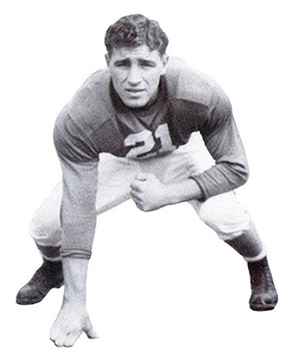
Former right guard Sam Buda, BS'44, DDS'45, came to the reunion, too. “Ask anyone what they remember about that final season,” Buda told the Creighton Window magazine, “and I’ll bet they mention Tulsa.”
Yet that wasn’t the moment Buda remembered most clearly. He would later say his fondest memory of that season came from a game a month prior to the Tulsa loss, when two of the 20th century’s greatest athletes came to Creighton Stadium.
This was the October home game against Fort Riley. The game itself wasn’t especially notable — 34-7 Creighton. More interesting were two members of Fort Riley’s segregated marching unit — world heavyweight champion boxer Joe Louis and future Major League Baseball player Jackie Robinson.
Few athletes in any time or place would be as socially or politically significant as Louis and Robinson. This was a few years after Louis had defended his title against the Nazi Germany-touted Max Schmeling, a few years before Robinson broke pro baseball’s color barrier.
And here they were, two enlisted men on Creighton’s field — a world at war, a nation on the brink of transformation, a team in its final days.
Weeks later, the war would finish Creighton football for good. But on that day, the stadium still stood, 10,000 fans cheered, and the Bluejays won the game.
It would have been the perfect ending to Creighton football, so much better than the Tulsa loss a month later. But, as luck would have it, the real ending to Creighton football wasn’t really the end either.
Read Part Three: 1983 — The “Rise” of Creighton Football
See old photos of the team and the stadium
Sources for this series: the University Archives, the Creightonian, the Blue Jay Yearbook, the Omaha World-Herald and the Creighton Window.
* * *
The football program may no longer exist, but we still have 14 varsity teams carrying on the proud tradition of Creighton Athletics. You can keep our many programs and student-athletes successful by making a gift today!
